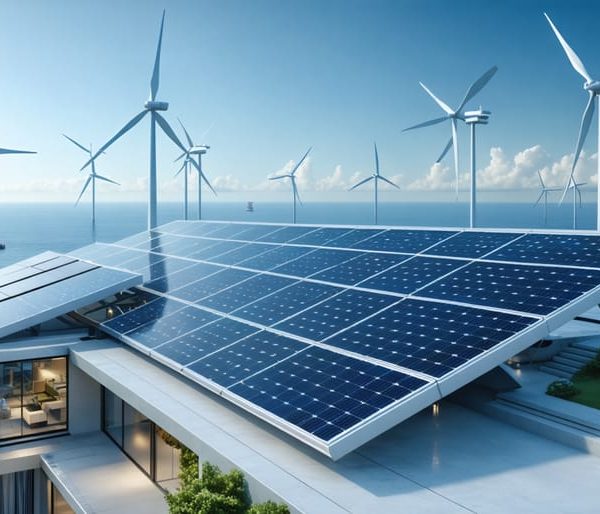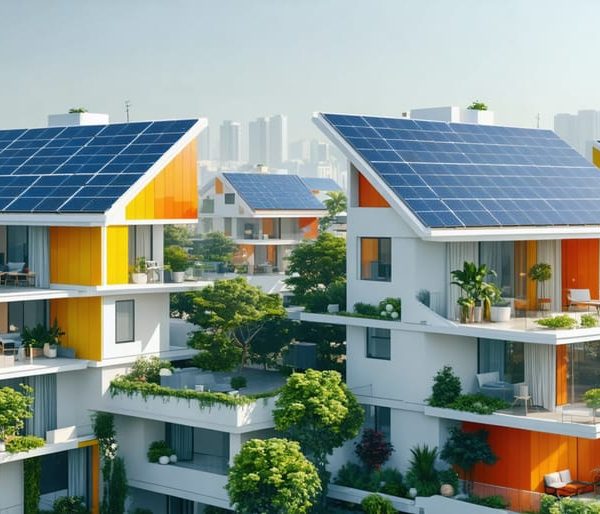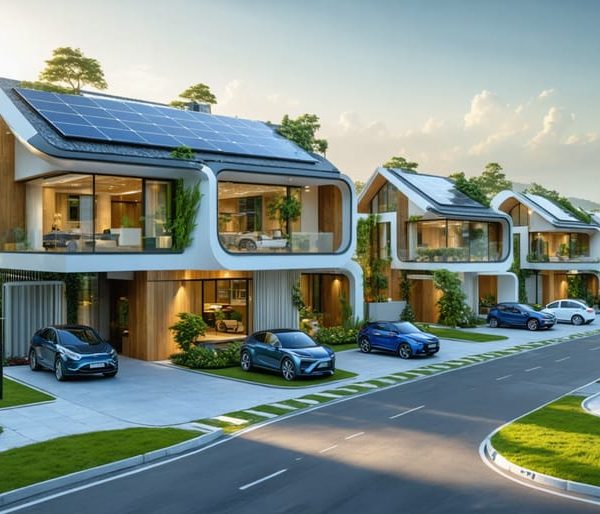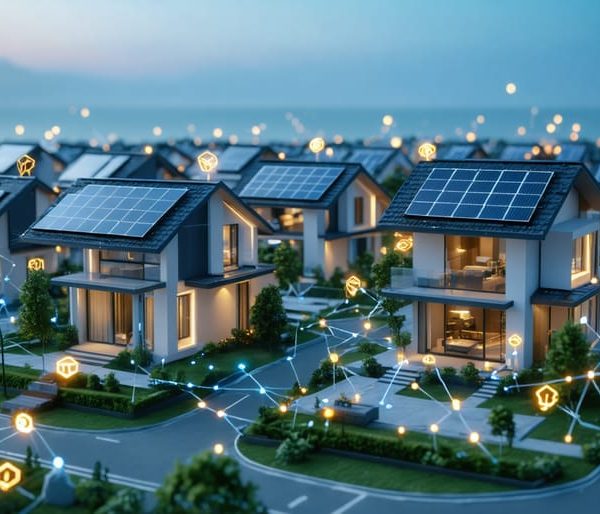These Breakthrough Solar Panels Will Cut Your Energy Bills in Half
Revolutionizing rooftop solar technology, innovative panels now transform sunlight into electricity with up to 40% more efficiency than traditional systems. These breakthrough designs incorporate bifacial cells that capture reflected light, transparent photovoltaic surfaces that double as windows, and artificial intelligence that automatically adjusts panel orientation for maximum energy harvest throughout the day.
Beyond improved efficiency, today’s solar innovations tackle common homeowner concerns head-on. Perovskite-based panels cost significantly less to manufacture while delivering comparable power output. Ultra-thin solar films conform to curved surfaces, enabling installation on virtually any roof design. Smart monitoring systems provide real-time performance data directly to your smartphone, putting energy management at your fingertips.
The future of home solar has arrived, and it’s more accessible than ever. Weather-resistant nano-coatings extend panel lifespan beyond 30 years, while modular designs allow for easy expansion as your energy needs grow. Whether you’re considering your first solar installation or upgrading existing panels, these technological advances offer unprecedented opportunities to slash energy bills while contributing to a sustainable future.
Perovskite Solar Cells: The Next Generation of Solar Power

How Perovskite Cells Work
Perovskite solar cells represent one of the most exciting new solar materials in renewable energy. These innovative cells work by using a special crystal structure that captures sunlight and converts it into electricity more efficiently than traditional silicon panels.
Think of perovskite cells as a super-thin sandwich of materials, with the special crystal layer doing most of the heavy lifting. When sunlight hits these crystals, they excite electrons, creating electrical current much like traditional solar panels, but with some impressive advantages. They’re lighter, thinner, and can be manufactured at lower temperatures, which means lower production costs for homeowners.
What makes perovskite cells particularly exciting is their flexibility. They can be printed like newspapers, sprayed onto surfaces, or even made semi-transparent for windows. Plus, they work well in low-light conditions, making them ideal for cloudy climates or north-facing roofs where conventional panels might struggle.
The best part? These cells can achieve impressive efficiency rates of over 25%, potentially delivering more power from the same roof space as traditional panels. For homeowners, this means more energy production in a smaller package, leading to greater energy savings and a faster return on investment.
Real-World Performance Benefits
Real-world testing shows that innovative solar panels are delivering impressive results for homeowners and businesses alike. Recent installations demonstrate 20-30% higher energy production compared to traditional panels, translating to significantly lower electricity bills. A typical household switching to these advanced panels saves an average of $850-1,200 annually on energy costs.
These cutting-edge panels perform exceptionally well in challenging conditions. During cloudy days, they maintain up to 80% efficiency, compared to the 40-50% efficiency of conventional panels. Their enhanced low-light performance means more energy generation during morning and evening hours, extending productive operating times by up to 2 hours daily.
Temperature tolerance is another game-changer. While traditional panels lose efficiency at high temperatures, innovative models maintain optimal performance up to 185°F (85°C). This results in consistent energy production even during scorching summer days when cooling needs are highest.
Durability improvements mean these panels last 25-30 years, about 5-7 years longer than conventional options. Combined with their higher efficiency, the long-term cost benefits are substantial. Users report reaching their return on investment 30% faster than with traditional solar installations, making the initial investment more attractive for budget-conscious consumers.
Bifacial Solar Panels: Double-Sided Energy Collection

Installation Requirements
For optimal performance, bifacial solar panels require specific installation conditions that maximize their unique two-sided design. These panels work best when mounted at least 3 feet above a reflective surface, such as white gravel, light-colored concrete, or specially designed reflective materials. The higher mounting allows sunlight to bounce off the ground and reach the rear surface effectively.
The panels should be installed at a tilt angle between 20-40 degrees, depending on your geographical location. This optimal angle ensures maximum exposure to both direct sunlight and reflected light. Avoid placing panels too close together, as this can create unwanted shadows that reduce rear-side efficiency.
The installation site should be free from obstacles that could cast shadows on either side of the panels. Consider the sun’s path throughout the year when planning panel placement. For roof installations, light-colored roofing materials can enhance performance. Ground-mounted systems benefit from proper landscaping with reflective ground cover.
Regular maintenance access should also be factored into the installation design, allowing easy cleaning of both panel surfaces for sustained efficiency.
Energy Generation Boost
These cutting-edge solar panels deliver an impressive 25-30% increase in energy generation compared to traditional models, making them a game-changing investment for your home or business. Real-world data shows that a typical 2,000-square-foot home can generate an additional 2,000-3,000 kWh annually with these innovative panels.
The enhanced efficiency translates directly to your bottom line. Homeowners who upgrade to these advanced panels typically see their investment returned within 4-6 years, compared to 7-8 years with conventional systems. For a standard 6kW system, this means saving an extra $300-500 annually on electricity bills.
What makes this possible is the combination of advanced photovoltaic materials and smart tracking technology. These panels can capture energy from both direct and indirect sunlight, maintaining steady power generation even during cloudy days. The built-in micro-inverters ensure optimal performance for each individual panel, maximizing energy harvest throughout the day.
Commercial properties see even more dramatic results, with some businesses reporting up to 40% reduction in their energy costs after switching to these innovative panels.
Smart Solar Panels with Built-in Optimization
Real-Time Performance Tracking
Modern solar panels now come equipped with sophisticated smart monitoring systems that transform how we track and optimize energy production. These intelligent features provide real-time data about your solar panel’s performance right on your smartphone or computer.
Imagine watching your energy production rise and fall throughout the day, just like checking the weather. These systems alert you instantly if a panel isn’t performing at its best, helping you address issues before they impact your energy bills. You’ll receive updates about everything from dust accumulation to shade interference, making maintenance more proactive than ever.
The data collected helps you understand your energy patterns better. You’ll see exactly when your panels are most efficient and can adjust your energy usage accordingly. For example, you might discover that running your dishwasher during peak sunlight hours maximizes your solar investment.
Many systems also include weather forecasting features that predict your panels’ expected performance. This helps you plan your energy usage around optimal production times. Plus, detailed monthly reports show your environmental impact, including how many trees you’ve saved and your carbon footprint reduction.
These smart features aren’t just convenient – they’re essential tools for maximizing your solar investment and ensuring your system operates at peak efficiency year-round.
Maintenance and Troubleshooting
Modern solar panels are revolutionizing maintenance through smart monitoring systems that take the guesswork out of upkeep. These intelligent systems use sensors and mobile apps to track your panels’ performance in real-time, alerting you to any issues before they become serious problems.
The latest maintenance technology includes self-cleaning features that detect dust and debris accumulation. When dirt is detected, these systems can either activate built-in cleaning mechanisms or notify you when manual cleaning is needed. Some advanced models even adjust their cleaning schedule based on local weather patterns and air quality data.
For troubleshooting, artificial intelligence-powered diagnostics can identify potential issues like reduced efficiency, connection problems, or hardware malfunctions. The system sends notifications directly to your smartphone, often with specific recommendations for fixes. Many problems can be resolved remotely through software updates or system resets, eliminating the need for service calls.
Regular maintenance is simplified through automated schedules that remind you when to perform basic checks. The system tracks performance metrics over time, making it easy to spot trends and anticipate needed repairs. Some smart panels even communicate directly with manufacturers’ service centers, automatically scheduling maintenance when necessary.
For DIY-minded owners, these systems provide step-by-step guidance for basic maintenance tasks, while also clearly indicating when professional help is required. This balanced approach helps maintain optimal performance while reducing long-term maintenance costs.
Aesthetic Innovations in Solar Design
Solar Roof Tiles
Solar roof tiles represent a revolutionary advancement in building integrated photovoltaics, seamlessly blending traditional roofing aesthetics with solar power generation. Unlike conventional solar panels, these tiles look virtually identical to standard roof shingles while incorporating high-efficiency solar cells.
Each tile functions as both a protective roofing material and a miniature solar panel, eliminating the need for separate mounted systems. They come in various styles and colors, matching classic slate, terracotta, or modern architectural designs. This aesthetic integration has made solar power more appealing to homeowners in historically preserved neighborhoods or areas with strict homeowners’ association guidelines.
Installation is straightforward, with certified professionals treating the process similar to traditional roofing. The tiles interlock securely, creating a weather-tight seal while maintaining their power-generating capabilities. Most systems include smart monitoring features, allowing homeowners to track energy production through user-friendly mobile apps.
While the initial investment may be higher than traditional solar panels, many homeowners find the dual functionality and enhanced curb appeal worth the premium.

Transparent Solar Panels
Imagine turning your windows into power generators while maintaining their transparency and functionality. Transparent solar panels represent a groundbreaking advancement in solar technology, offering homeowners the ability to harvest energy from sunlight without compromising their home’s aesthetic appeal or natural lighting.
These innovative panels use specialized organic molecules that capture invisible ultraviolet and infrared light while letting visible light pass through. When integrated into windows or glass surfaces, they can transform ordinary glass features into subtle energy producers. A typical installation can achieve 5-10% efficiency while maintaining up to 70% transparency, making them ideal for sunrooms, skylights, and large window arrays.
Homeowners are increasingly installing these panels in conservatories and glass extensions, effectively turning previously unused surfaces into power-generating assets. The technology also shows promise for retrofitting existing windows, though currently at a higher cost than traditional solar panels. Early adopters report satisfaction with the dual benefits of natural lighting and energy generation, despite the initial investment.
As manufacturing scales up and technology improves, transparent solar panels are becoming an increasingly viable option for sustainable home design, particularly in urban areas where roof space is limited.
Making the Switch: Practical Considerations
Making the switch to innovative solar panels requires careful planning and consideration of several key factors. As solar technology breakthroughs continue to emerge, homeowners have more options than ever before.
Start by assessing your property’s solar potential. Consider factors like roof orientation, shade coverage, and available space. South-facing roofs typically receive the most sunlight in the Northern Hemisphere, making them ideal for solar panel installation. If your roof isn’t optimal, ground-mounted systems or solar awnings might be better alternatives.
Next, evaluate your energy needs by reviewing past electricity bills. This helps determine the system size required to meet your household’s consumption. Remember to factor in future needs, such as electric vehicle charging or home additions.
Consider your budget and available incentives. Many regions offer tax credits, rebates, and grants for solar installations. Research local programs and federal incentives to maximize your investment. Also, explore financing options like solar loans or lease agreements if upfront costs are a concern.
Choose a reputable installer with experience in newer solar technologies. Request multiple quotes and check references. Ask about warranty coverage, maintenance requirements, and performance guarantees. Make sure they’re certified and familiar with local building codes and permit requirements.
Timing is also crucial. While installation can occur year-round, planning during off-peak seasons might result in better pricing and shorter wait times. Consider starting the process 3-6 months before your desired installation date to allow time for permits, inspections, and utility approvals.
As we look toward a more sustainable future, innovative solar panels represent more than just an energy solution – they’re a gateway to environmental stewardship and financial independence. These cutting-edge technologies have revolutionized how we harness the sun’s power, offering unprecedented efficiency, durability, and adaptability for both residential and commercial applications.
The benefits are clear and compelling: reduced carbon footprint, significant energy cost savings, and increased property value. Modern solar installations can now integrate seamlessly with smart home systems, adapt to challenging weather conditions, and even generate power from indirect sunlight. With improved aesthetics and flexible installation options, there’s never been a better time to embrace solar technology.
Early adopters are already experiencing the advantages, reporting energy savings of up to 90% and quick returns on their investments. As manufacturing costs continue to decrease and efficiency levels rise, solar power becomes increasingly accessible to homeowners and businesses alike.
Taking the step toward solar adoption isn’t just about personal benefit – it’s about being part of a larger movement toward sustainable living. With government incentives, flexible financing options, and professional installation services readily available, the barriers to entry have never been lower. By choosing innovative solar technology today, you’re investing in a cleaner, more sustainable tomorrow while securing long-term energy independence for your home or business.











